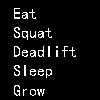How many repetitions?
 |
|

02-10-2008, 04:50 AM
|
|
Rank: New Member
|
|
Join Date: Feb 2008
Location: Windhoek, Namibia, Africa
Posts: 1
|
|
 How many repetitions?
How many repetitions?
Since the beginning of ages people have debated what is the
optimum amount of repetitions to build the most muscle
size.
The answer is not that simple since there is a slight
overlapping training effect between different repetition
schemes.
The question should rather be what you want to achieve.
To achieve maximum results don't mix up different
repetition schemes, although it can be done. You don't want
to mix up the specific stimulus you want to deliver to the
muscle fibres.
In short these are the three repetition schemes that you
might want to use and what effect they are going to have on
you're muscles.
1-4 reps (building strength)
5-8 reps (building muscle size)
9-25 and more reps (building muscle endurance)
Use only compound exercises with as much weight as
possible, which will allow you to work between 5-8 reps.
The moment you can do 8 or more reps, increase the weight
slightly.
Compound exercises are done with barbells and dumbells.
Forget about any isolation exercises. Isolation exercises
simply do not tax the muscle fibres enough to cause the
growing effect.
If you do have the choice between barbells and dumbells
take the barbells. Write this into your mind. The heavier
weight you can use in your exercises the more effective
you're going to build muscle.
Never use loose form. Although you are going to use heavy
weights, use strict form in your exercises to maximize
results and prevent injuries.
These are the best compound exercises for building muscle
size. Deadlifts, squats, leg presses, bench presses,
bentover rowing, normal or weighted pullups, military
presses, barbell curls, close-grip bench presses, standing
and seated calf raises.
There are of course other factors that also play a major
role in developing muscle size, but to many times I find
people fooling around with light weights and doing a
rediculious amount of repititions.
Start using the correct repetition range today and in three
months time your body might look completely different.

|

02-10-2008, 06:51 AM
|
 |
Rank: Light Heavyweight
|
|
Join Date: Jan 2007
Location: NC
Posts: 3,268
|
|

Strength and Conditioning Journal: Vol. 22, No. 6, pp. 67–69.
Brad Schoenfeld, CSCS
Personal Training Center for Women, Scarsdale, New York
Key Words: repetitions, muscular mass
MANY EXERCISE-RELATED factors influence muscular mass. Among them is repetition range—the amount of repetitions performed
during a set. Unfortunately, this is one of the most misunderstood aspects of training.
Most people realize that the use of a high number of repetitions (in excess of 15 per set) is suboptimal for increasing muscular mass.
The reason for this is simple: during a high-repetition set, the weights used aren't heavy enough to innervate the highest threshold motor units. These motor units control the fast-twitch, type IIB fibers—the ones that have the greatest potential for growth.
Rather, the majority of work is accomplished by slow-twitch type I fibers, which are fatigue resistant but have a limited ability to hypertrophy. Thus, although high-repetition training is an excellent approach for heightening local muscular endurance and improving the quality of muscle tissue, it produces only minimal gains in muscular size.
On the other hand, there is a prevailing misconception that in order to get big, one needs to train like a powerlifter, using extremely heavy weights and low repetitions (less than 5 per set). It is common to witness an aspiring bodybuilder load up the bar and perform sets of squats or bench presses at or near his or her 1-repetition maximum. This approach, however, is contrary to established principles of exercise physiology. For a variety of reasons, a moderate-repetition scheme (approximately 8 to 10 repetitions per set) is the decidedly better choice for achieving optimal gains in muscular mass. First, training in a moderate-repetition range stimulates the activation of a maximum number of muscle fibers. This is because of the size principle of muscle recruitment, which dictates that motor units are innervated in an orderly fashion. Smaller motor units are activated first. As a set becomes more intense, larger motor units are progressively brought into play until all available fibers are recruited. This is the general pattern of recruitment seen during moderate-repetition training, and it allows the full spectrum of fibers to exert force.
Alternatively, because low-repetition training requires an explosive concentric effort, the size principle can be short circuited. There is evidence that in a ballistic lift, synaptic-input systems cause the preferential recruitment of high-threshold motor units while inhibiting lower threshold motor units (15). Accordingly, smaller fibers are bypassed in favor of those with greater force potential. Although small fibers don't have the ultimate growth potential of larger fibers, they do, to a certain extent, contribute to muscle hypertrophy. Therefore, because of a reduced involvement of low-threshold neurons, the potential for muscular development is ultimately diminished.
Second, the secretion of endogenous, anabolic hormones is highest after a moderate-repetition set (8). After a muscle has been subjected to intense stress, these hormones help to instigate the growth process. As a rule, the greater the amount of circulating anabolic hormones, the greater the potential for increases in muscular hypertrophy.
It is theorized that lactic acid plays a central role in exercise-related hormonal excitation (11). Although many people tend think of lactic acid as an impediment to exercise, it is actually a potent anabolic facilitator. Lactic acid is generated as a byproduct of glycolysis, the energy system that is the primary fuel source used during moderate-repetition training. When lactic acid accumulates in large amounts, there is a corresponding surge in anabolic hormone levels. Conversely, because low-repetition training predominantly relies on the short-term phosphocreatine system for energy—not on glycolysis—only a limited amount of lactic acid is produced. Hence, the secretion of endogenous hormones is somewhat blunted.
Testosterone levels, for example, are significantly higher after a 10-repetition set when compared with the case after a 1-repetition maximum (3). Although the exact mechanism is still unclear, lactic acid somehow potentiates the release of cyclic adenosine monophosphate (cAMP)—a chemical messenger that acts a catalyst in cellular function. cAMP, in turn, promotes the secretion of testosterone, which then directly acts on the muscle cell to stimulate growth (9).
In addition, lactate has a significant impact on growth hormone (GH) secretion. A 10-repetition set has been shown to produce large increases in circulating GH—much greater than in a lower-repetition protocol (6). Moreover, these effects are fairly well sustained; they are seen for more than an hour after the workout (7). And the benefits of this are twofold: not only is GH itself a powerful stimulator of muscular growth, but it also mediates the release of insulin-like growth factor (specifically, IGF-1), perhaps the most potent of all anabolic hormones.
Third, moderate-repetition training augments myofibrilar hydration (14). During training, the veins taking blood out of working muscles collapse. However, the arteries continue to deliver blood into the muscles, creating an increased concentration of intramuscular blood plasma. This causes plasma to seep out of the capillaries and into the interstitial spaces (the area between muscle cells and blood vessels). The buildup of fluid in the interstitial spaces causes an extracellular pressure gradient, which causes a flow of plasma back into the muscle. The net result: blood pools in your muscles, causing the phenomenon commonly referred to as a “pump.”
People tend to think of a pump as a temporary condition that is strictly cosmetic. However, this belief is shortsighted. Numerous studies have demonstrated that a hydrated cell stimulates protein synthesis and inhibits proteolysis (protein breakdown; 4, 10, 13). In this way, muscles are provided with the raw materials to lay down new contractile proteins—the basis for muscle tissue growth. Unfortunately, during low-repetition training, the time under tension simply isn't sufficient to generate a pump. Consequently, cell volume is relatively constant, and the impetus for protein synthesis is thereby reduced.
Fourth, by increasing time under tension, a moderate-repetition set maximizes muscle damage—a fact that has been shown to be imperative to increases in muscular hypertrophy (2). Theoretically, the longer that cross-bridge formation is maintained during training, the greater the potential for damage to the tissue. Because the duration of cross-bridge formation is shorter in a low-repetition set than in a moderate-repetition set, there is less time for myofilamental damage to take place.
It is important to note that these concepts are predicated on the overload principle, which states that a muscle must be taxed beyond its present capacity for growth to occur (5). Hence, all sets (excluding warm-ups) should be performed at a high level of intensity. This is an essential factor for promoting gains in size and strength (1, 12). Clearly, without muscular overload, results will be compromised.
In final analysis, there is substantial evidence that training in a moderate-repetition range is the superior method for building muscular mass. As discussed, it optimizes fiber recruitment, increases hormonal response, enhances cellular hydration, and heightens myofilamental damage. These factors work synergistically, combining to stimulate muscular growth. But does this mean that lower repetitions should never be employed in a mass-building program? Certainly not. Low-repetition sets can help to improve neuromuscular response, which in turn can translate into the ability to use heavier weights. Similarly, some high-repetition sets can also be employed to refine muscular endurance and raise lactate threshold. Still, if mass is your goal, the majority of training should be performed in a glycolytic mode, keeping repetitions between 8 to 10 per set.
--------------------------------------------------
I think this is a better explanation. It's a little more accurate also.

|

02-10-2008, 06:59 AM
|
 |
Rank: Light Heavyweight
|
|
Join Date: Jan 2007
Location: NC
Posts: 3,268
|
|
Isolation exercises have their place. That makes it sound like they should never be done. They should be...and they absolutely do "tax the muscle fibers enough to cause the muscle growing effect" when done correctly. The point is to target a specific muscle.
Dumbbells are great...I don't know why you would only want to train with barbells.
Mixing up repetition ranges can be a great thing. I believe it is called for specifically in the HST Training program listed in the Training Forum.
|

02-10-2008, 08:42 AM
|
 |
Rank: Middleweight
|
|
Join Date: Nov 2005
Posts: 2,238
|
|
What about sets? What difference does one rep make? According to the OP 4 reps is strength but 5 is size, similarly with 8 and 9...
__________________
"Pain don't hurt" - Dalton
"NO, this is my squat rack. Go get your own!"
"Damn that's shit heavy" - Wolf
To view links or images in signatures your post count must be 10 or greater. You currently have 0 posts.
To view links or images in signatures your post count must be 10 or greater. You currently have 0 posts.
|

02-10-2008, 08:54 AM
|
|
Rank: Heavyweight
|
|
Join Date: Jul 2005
Posts: 6,314
|
|

Yeah. Most of the time we say up to twelve is for growth and past that is "endurance". But you could ask the same question and say what's the big difference between 12 and 13. The answer of course is there is not a bif difference. That is why they call them rep "ranges". And the truth is you can do up to 15 reps and still get 'size' from it. But then you start to ask the same question again and eventually there has to be a cut-off. This is why I always say you are getting into endurance range but I don't say "you are training endurance".
Ultimately to get as "big" as possible and as "strong" as possible you'll need all the rep 'ranges'.
I do 15 reps or more on (back) extensions quite often. Does it make my lower back bigger? Yes. But maybe the real purpose is I want to train local muscular endurance since that is what I need at the time. And that will help me pull heavier or more or what have you and that will get me stronger overall. So is some rep nazi going to come on and tell me that is wrong? The point being, everything can be useful you just have to know when and how.
Some simple little one size fits all stuff may be ok when your first start but it won't get you all the way.
As far as the heaviest possible weight, via barbell, always being the best for whatever reason, well, that is just a big crock of poo-poo.
__________________
To view links or images in signatures your post count must be 10 or greater. You currently have 0 posts.
To view links or images in signatures your post count must be 10 or greater. You currently have 0 posts.
or
To view links or images in signatures your post count must be 10 or greater. You currently have 0 posts.
If you act sanctimonious I will just list out your logical fallacies until you get pissed off and spew blasphemous remarks.
|

02-10-2008, 07:12 PM
|
 |
Rank: Member
|
|
Join Date: Jan 2008
Location: SoCal
Posts: 55
|
|
Dumbbells and isolation exercises have their place. Dumbells allow for greater range of motion and therefore more flexibility and range of contraction of the muscle than a bar does, I can really feel the difference between bench press and flat dumbbell press. Isolation exercises are meant to also build mass, but primarily to sculpt and shape the muscle into symmetrical and aesthetic shapes. If you do only mass building exercises, you will end up with a clump of muscle for what should be a bicep. Barbells and heavy weights are definetly used for mass and strength gains as mentioned.
By the way, great info Ross.
|

02-10-2008, 07:45 PM
|
 |
Rank: Middleweight
|
|
Join Date: Nov 2005
Posts: 2,238
|
|
Quote:
Originally Posted by OTIS

Isolation exercises are meant to also build mass, but primarily to sculpt and shape the muscle into symmetrical and aesthetic shapes. If you do only mass building exercises, you will end up with a clump of muscle for what should be a bicep.
|
I'm gonna disagree with this statement. 
|

02-11-2008, 03:56 AM
|
 |
Rank: Lightweight
|
|
Join Date: Oct 2006
Location: New Jersey
Posts: 1,357
|
|
I have to agree with Kane. When I finally stopped laughing out loud I began to wonder if my arm looks like a clump, a lump or maybe something else...... 
__________________
Height: 6 foot
Weight: 240 pounds
Bench: 415 (1x1)
Deads: 565 (1x1)
A2G Squat: 425 (1x1)
Cardio sucks
To view links or images in signatures your post count must be 10 or greater. You currently have 0 posts.
|

02-11-2008, 04:07 AM
|
 |
Rank: Member
|
|
Join Date: Jul 2007
Location: Kentucky
Posts: 150
|
|
Agreed...  Because genetics has nothing to do with the shape of your muscles, right?...LoL If only I had known dumbells were the key... Damnit!!!
__________________
You come into the world weak, and you will leave the world weak. What you do in between is up to you!
|

02-11-2008, 05:42 AM
|
 |
Rank: Lightweight
|
|
Join Date: Aug 2007
Location: philly
Posts: 1,405
|
|
i agree with the range of motion for dumbells. i find you can get a lot deeper on pressing exercises.
|
 |
|
|
Currently Active Users Viewing This Thread: 1 (0 members and 1 guests)
|
|
|
| |
|

